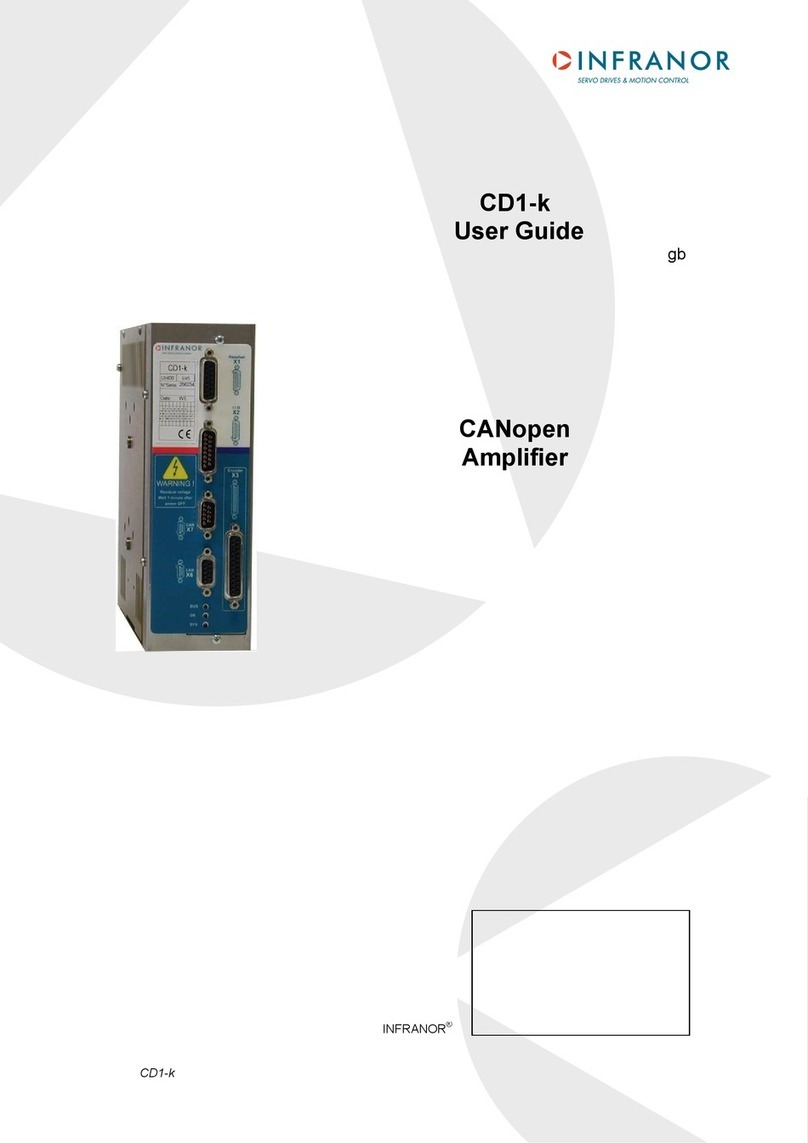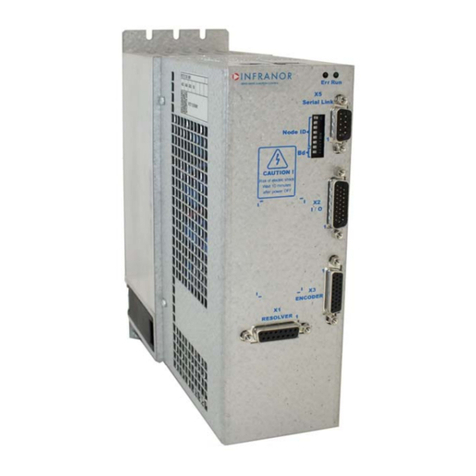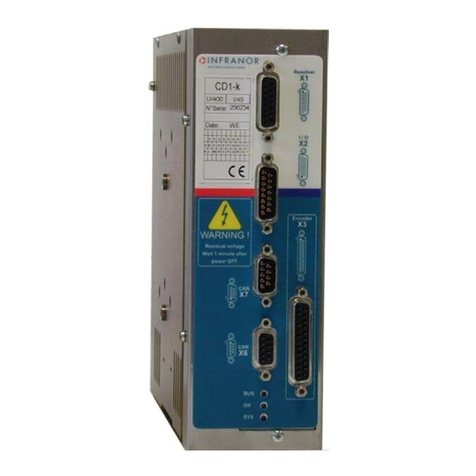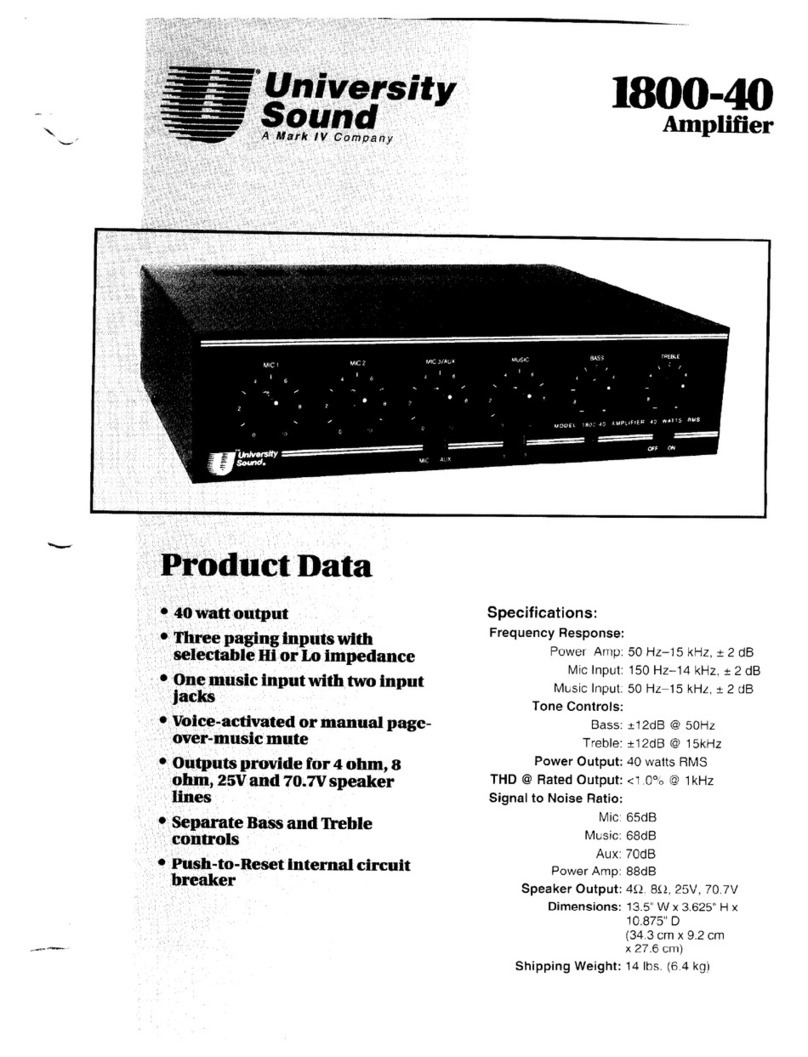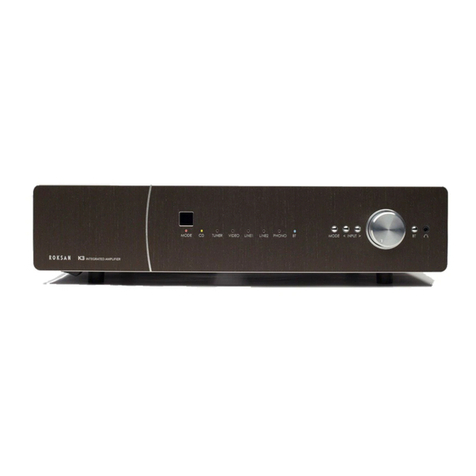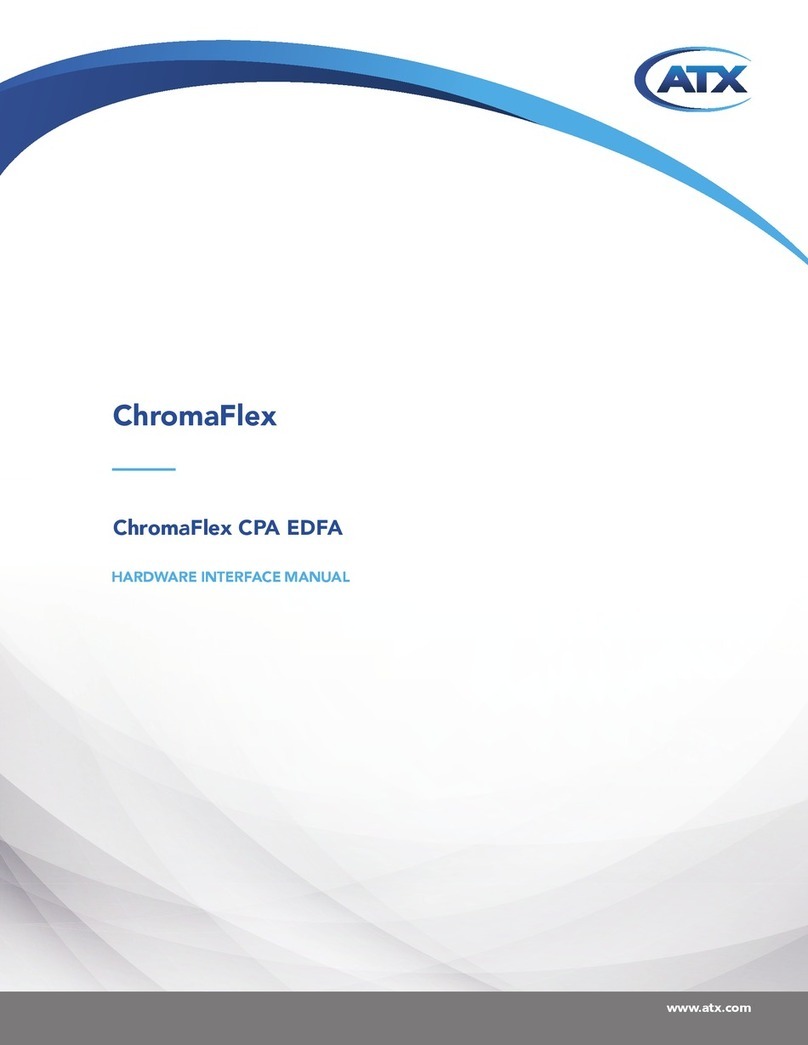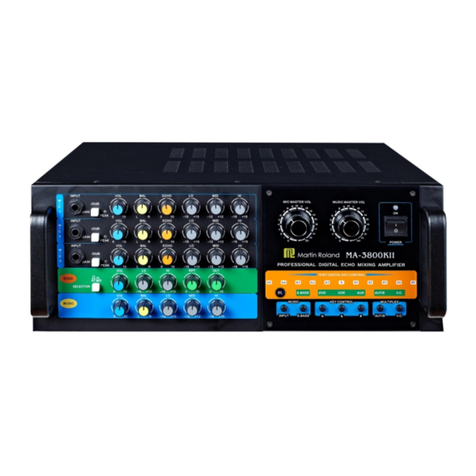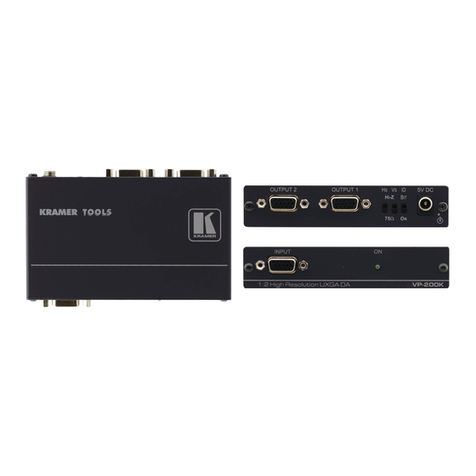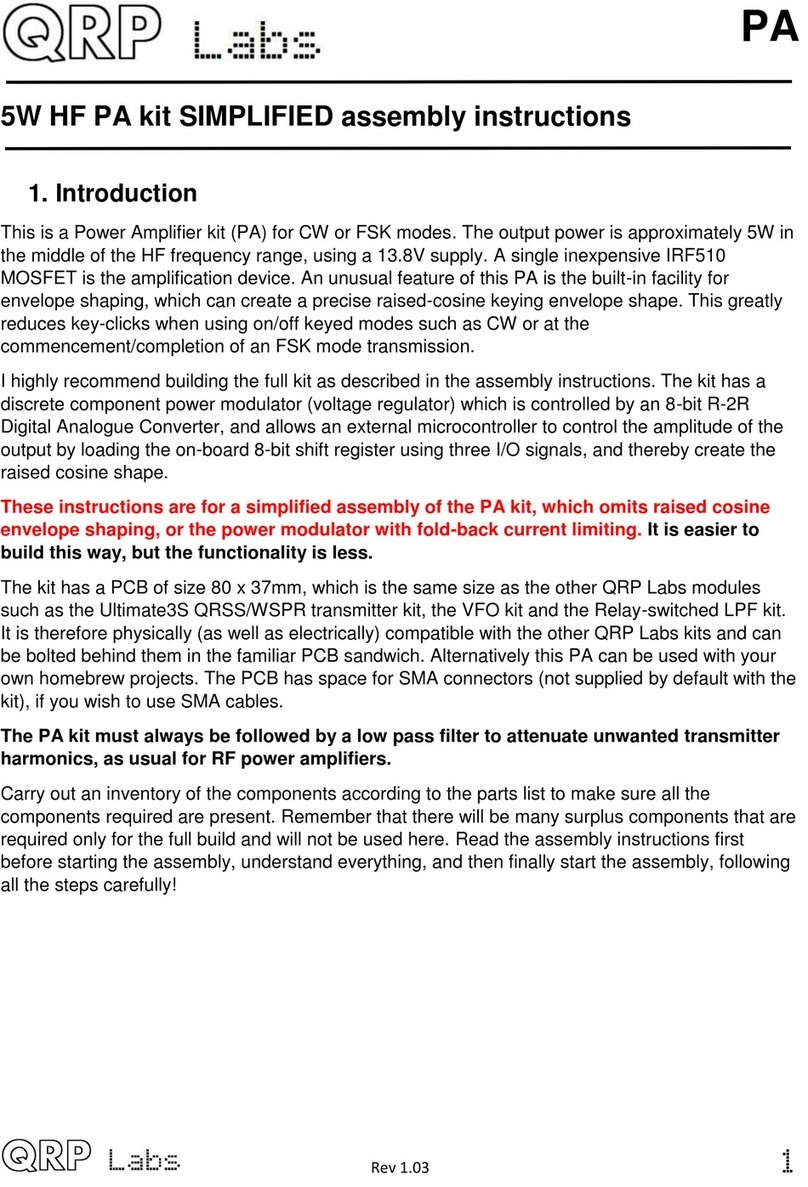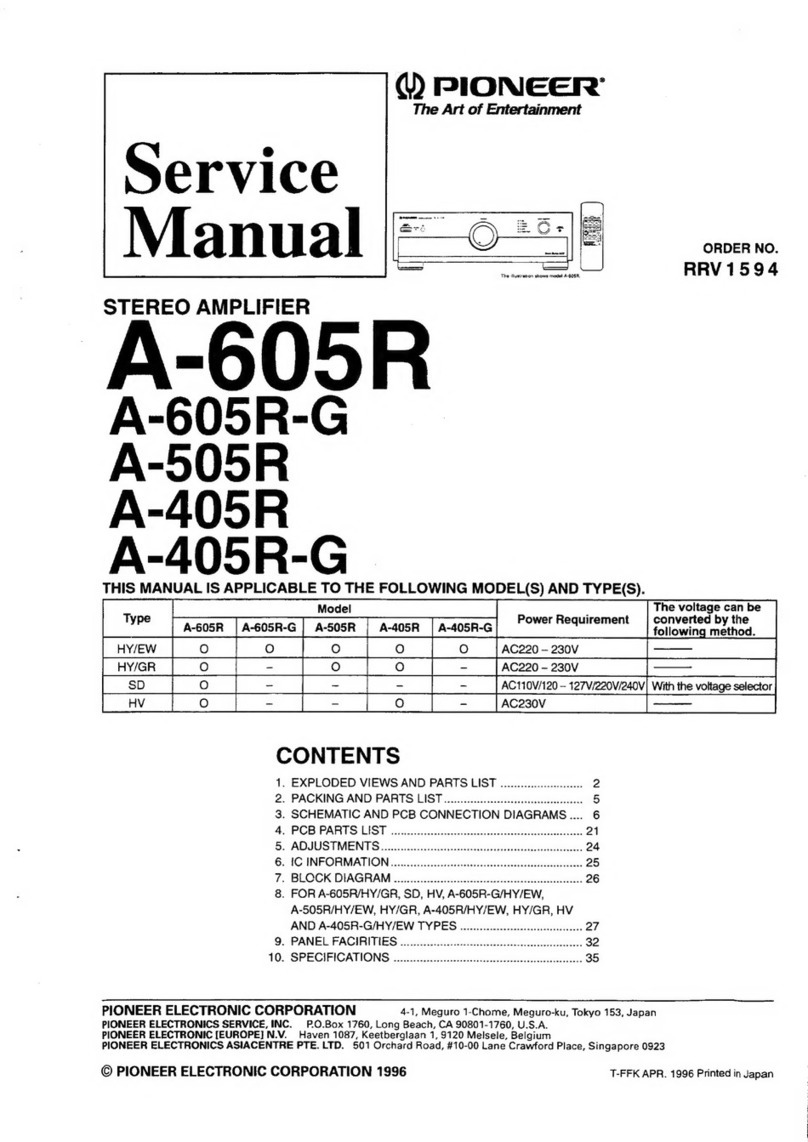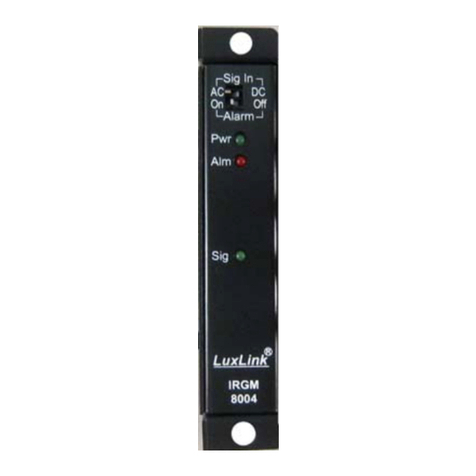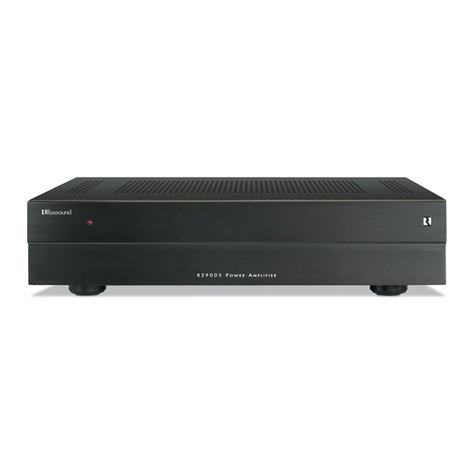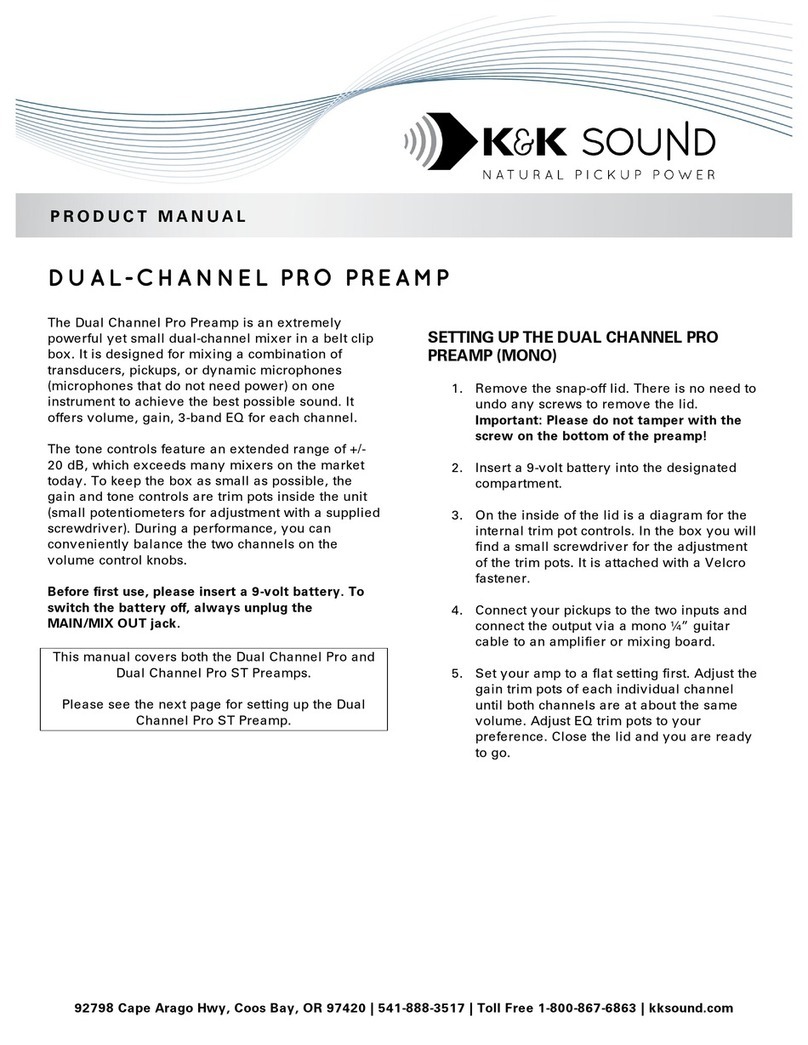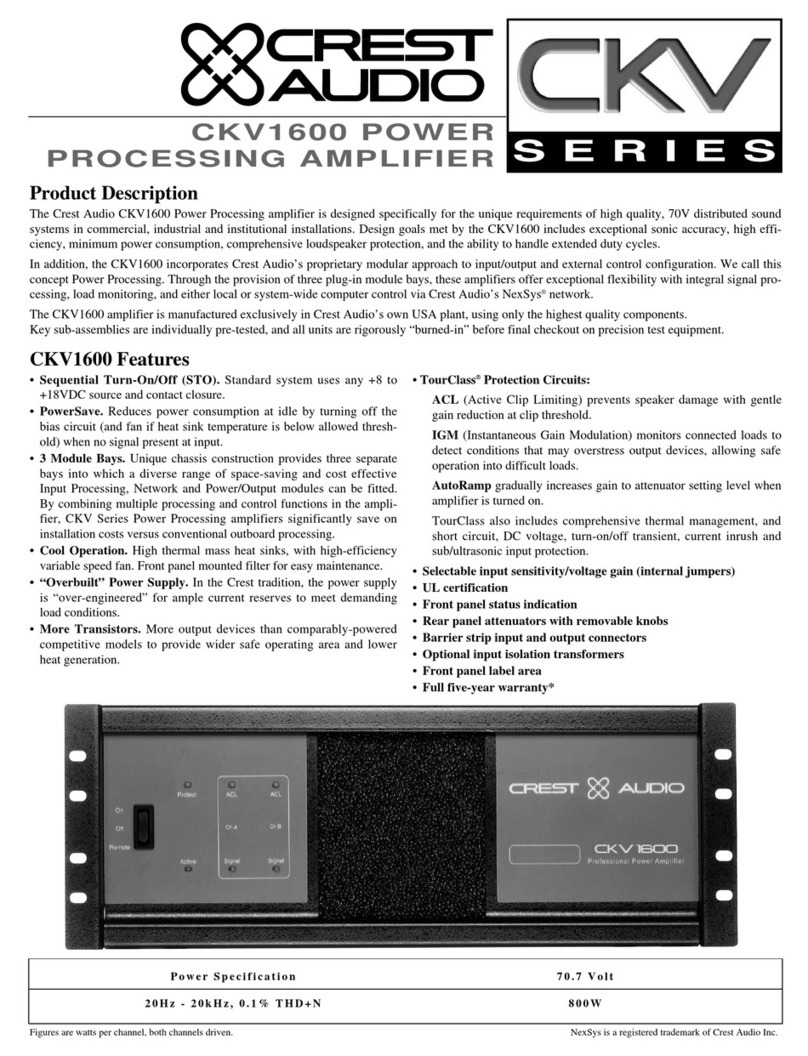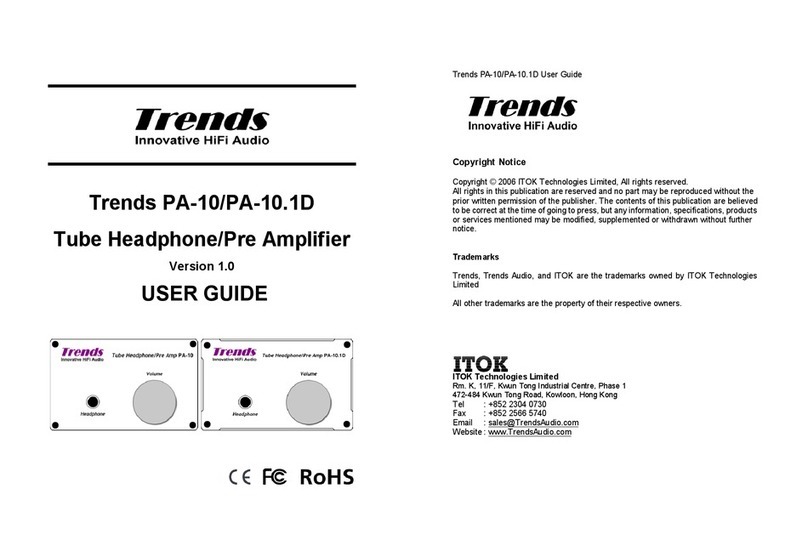Infranor SMT-BD1 Series User manual

1
This manual describes the option "c" of the SMT-BD1 amplifier: Positioning in stepping motor
emulation. The general information about the digital amplifier commissioning are described in
the standard SMT-BD1 manual. This manual may be used in conjunction with appropriate and
referenced drawings pertaining to the various specific models.
Maintenance procedures should be attempted only by highly skilled technicians (EN 60
204.1 standard) using proper test equipment.
The conformity with the standards and the "CE" approval are only valid if the items are installed
according to the recommendations of the racks and amplifiers manuals.
Any contact with electrical parts, even after power down, may involve physical damage.
Wait for 30 seconds after power down before handling the rack or the amplifiers (residual
voltage).
INFRANOR does not assume any responsibility for any physical or material damage due to
improper handling or wrong descriptions of the ordered items.
Infranor reserves the right to change any information contained in this manual without notice.
This manual is a translation of the original document and does not commit INFRANOR's responsibility. The
french manual is the only reference document.
© INFRANOR, April 1998. All rights reserved
Updating index: 2.01

2

3
Option "c"
POSITIONING IN STEPPING MOTOR EMULATION
WITH SMT-BD1/c AMPLIFIER

Option "c" · Contents
4
CONTENTS
CHAPTER 1 - GENERAL DESCRIPTION ......................................................................................5
CHAPTER 2 - SPECIFICATIONS...................................................................................................6
1 - TECHNICAL DATAS .................................................................................................................6
2 - AMPLIFIER BLOCK DIAGRAM ..................................................................................................7
3 - STORED FAULT .......................................................................................................................8
CHAPTER 3 - INPUTS - OUTPUTS ................................................................................................9
1 - X2 POSITION CONNECTOR.......................................................................................................9
1.1 -Pins reference........................................................................................................................9
1.2 - Logic outputs specification .....................................................................................................9
1.3 - Indexer input specification ....................................................................................................10
2 - X3 TEST CONNECTOR ...........................................................................................................11
CHAPTER 4 - CONNECTIONS ....................................................................................................12
1 - CONNECTION DIAGRAMS ......................................................................................................12
1.1 - TTL indexer signals.............................................................................................................12
1.2 - Differential indexer signals...................................................................................................12
2 - WIRING RECOMMENDATIONS ...............................................................................................12
CHAPTER 5 - ADJUSTABLE PARAMETERS...............................................................................13
1 - OPERATION MODE .................................................................................................................13
2 - APPLICATION PARAMETERS .................................................................................................13
3 - POSITION REGULATOR PARAMETERS ..................................................................................14
CHAPTER 6 - COMMISSIONING ................................................................................................15
1 - CHECKING THE CONFIGURATION..........................................................................................15
2 - POWERING .............................................................................................................................15
3 - START AND ADJUSTMENT ....................................................................................................15
CHAPTER 7 - FAULT FINDING...................................................................................................17
1 - POSITION FAULT ...................................................................................................................17
2 - OPERATING PROBLEMS.........................................................................................................17
2.1 - Loud crackling noise in the motor at standstill.........................................................................17
2.2 - Loud noise in the motor at standstill and when running ............................................................17
2.3 - Loud noise in the motor when running....................................................................................17
2.4 - Motor position oscillations at standstill..................................................................................17
CHAPTER 8 - APPENDIX ............................................................................................................18
LOCATION DIAGRAM OF THE HARDWARE OPTIONS .................................................................18

Option "c" · Chapter 1: General description 5
CHAPTER 1 - GENERAL DESCRIPTION
Applications with positioning in stepping motor emulation require the SMT-I2-BD1 daughter
board on the SMT-BD1 amplifier as well as the firmware memory version X.XC. In this
configuration, the SMT-BD1/c amplifier controls the motor shaft position by means of the
resolver sensor with a programmable resolution of 4 to 32 768 ppr. The position input command
is received as two TTL level signals (0 to 5 V): one pulse train (PULSE) indicating the shaft
motion and one direction signal (DIR) indicating the motion direction. These signals enter the
amplifier X2 position connector. This kind of input allows a direct interfacing with an indexer or
a PLC board, as shown below.
All boards which are compatible with the above described inputs can be used, but some
important specifications of the board should be checked in order to obtain satisfying results.
For "soft" motions (without motor jerking, without saturation in the amplifier and without
important overshoot) the board MUST generate acceleration / deceleration ramps during the
motion (trapezoidal shape).
The maximum output pulse train frequency of the board limits, at the same time, the motor
maximum speed and the position resolution according to the formula below:
Max. PULSE signal frequency (pps) = Max. motor speed (rpm). Motor position resolution (ppr)/60
The maximum value of each motion in number of pulses (Pulses) is also depending on the
board.
The shaft initializing procedures are completely controlled by the board and the various
possibilities are depending on the board.
When the amplifier is disabled (ENABLE input not active), the input pulses are not counted.
When activating the ENABLE input, the motor is enabled at its current position and follows the
input pulses emitted by the board. The motor shaft motion depends on the selected position
resolution.
The position error between input command and motor is controlled in the amplifier. The
position regulator also allows to reduce the following error during the motions, if necessary.

Option "c" · Chapter 2: Specifications
6
CHAPTER 2 - SPECIFICATIONS
1 - TECHNICAL DATAS
Motor position input command One pulse train (f) + one direction signal
Maximum frequency: f = 1 MHz
Number of steps per motor revolution Motor encoder resolution . 4
Programmable motor encoder resolution Max. 8 192 ppr up to 900 rpm
Max. 4 096 ppr up to 3 600 rpm
Max. 1 024 ppr up to 14 000 rpm
Drive position repetability 1 step
Drive position accuracy (*) 8 Arc mins + 1 step in standard
(2 Arc mins + 1 step on special request)
Position regulator PIV + Feedforward Sample period: 0,5 ms
Integrator antisaturation system
Antiresonance filter
Adjustable digital gains
Position loop bandwidth Cut-off frequency for 45°phase shift
Selectable: 50 Hz, 75 Hz or 100 Hz
Logic outputs POS : Position following OK
(*) The resolver accuracy must be taken into account for the total accuracy.

Option "c" · Chapter 2: Specifications 7
2 - AMPLIFIER BLOCK DIAGRAM
3/4
5/6
1/2
18/19
16/17
3/15
1
14
7
4
20
13
5/9 4/8 3/7 1/2
I2t
U V W
+15V
0V
-15V
1/26
29
64/32
PR8
-UP +UP
X1
X2
X4
1/6 3 4 2 5
X3 X5 5 2/3 7/8 6/9 XX X XX X
PR10
P err
Vmes
Vref
IQ
ID
Imes
Idc
13/10
15/11
MOTOR
Resolver
Ref SIN COS T¡mot
GT
Resolver
conversion
Resolver
oscillator
Encoder
output
CA
CB
CZ
AOK
CV Analog
input
Analog
input
ILIM
fc+
fc-
CV0
CI
Enable
RESET
CV GT
Ramp
fdc Speed
loop
d / dt
Vector
control Current
loops
EEPROM
Serial
interface
Current
monitor
Pmes
Imes
ID IQ
PWM
Protections
T¡mot
Enable
Logic
supplies
·ENABLE
AOK
ERROR SYS ON
Power fault
Enable
DC BUS
fc+ fc- CV0
Vref
Vmes
IDC
Selectable
outputs
POS
SMT-I2-BD1
option board
Position
input Position
loop

Option "c" · Chapter 2: Specifications
8
3 - STORED FAULT
The stored fault can be cancelled: - by the RESET function of the BPCW software,
- by the fault RESET input (pin 13 of X4),
- by turning off the amplifier supply.
PROTECTION DISPLAY CODE LED
Position following error Position ll
lR
l= LED is unlit R= LED is lit

Option "c" · Chapter 3: Inputs - Outputs 9
CHAPTER 3 - INPUTS - OUTPUTS
1 - X2 POSITION CONNECTOR
1.1 -PINS REFERENCE
PIN FUNCTION I/O REMARK
1 CZ/ O Motor encoder output of the zero pulse/ (5 V, 20 mA max)
2 CZ O Motor encoder output of the zero pulse
3 CA/ O Motor encoder output channel A/ (5 V, 20 mA max)
4 CA O Motor encoder output channel A
5 CB/ O Motor encoder output channel B/ (5 V, 20 mA max)
6 CB O Motor encoder output channel B
7 0 V GND
8 POS O Logic output POS : position following OK
23 0 V POS O 0 V POS output
10 0 V GND
11 0 V I Indexer 0 V input
13 PULSE I Indexer PULSE signal input (Chapter 3, ¤ 1.3)
12 PULSE/ I Indexer PULSE/ signal input (Chapter 3, ¤ 1.3)
15 DIR/ I Indexer DIR signal input (Chapter 3, ¤ 1.3)
14 DIR/ I Indexer DIR/ signal input (Chapter 3, ¤ 1.3)
16,17,18,19 Reserved Reserved
9 Reserved Reserved
20,21,22 Reserved Reserved
24,25 Reserved Reserved
1.2 - LOGIC OUTPUTS SPECIFICATION
The POS output is an "open collector" and "optocoupled". The transistor is disabled if a fault
occurs. The traditional application scheme is shown below. The maximum output current is 5
mA.

Option "c" · Chapter 3: Inputs - Outputs
10
1.3 - INDEXER INPUT SPECIFICATION
The TTL PULSE and DIR inputs are connected to the amplifier as shown below:
For indexers with open collector output and operating at high frequencies (> 100 kHz), a pull-up
resistor corresponding to the transistor output current must be wired in the X2 connector, as
shown below (the pull-up resistor is parallel mounted to the 1 kWresistor in the amplifier).
The differential PULSE and DIR inputs are connected to the amplifier as shown below:
This type of input is suitable for long indexer-amplifier connections (a 26LS31 driver is
recommended).

Option "c" · Chapter 3: Inputs - Outputs 11
2 - X3 TEST CONNECTOR
PIN FUNCTION CHARACTERISTICS
1 - 6 0 V
2 DAC 1 output ±10 V resolution 8 bits, linearity: 2 % (IDC, Imon., ID, IQ,
Vref, Vmon., Pos err) *
3 Speed input command CV ±10 V for ±maximum speed
4 Speed signal GT ±8 V for ±14 000 rpm
5 DAC 2 output ±10 V resolution 8 bits, linearity: 2 % (IDC, Imon., ID, IQ,
Vref, Vmon., Pos err)*
* : See "BPCW Options" manual, part "Digital oscilloscope".
Linearity = 10 % on logic board types 01612A, 01612B and 01612C.

Option "c" · Chapter 4: Connections
12
CHAPTER 4 - CONNECTIONS
1 - CONNECTION DIAGRAMS
1.1 - TTL INDEXER SIGNALS
1.2 - DIFFERENTIAL INDEXER SIGNALS
2 - MANDATORY WIRING
For the incremental position input command signals Pulse and Direction of the indexer-
amplifier connection, use a cable with a 360°shield connection via the metal plated
connectors at both cable ends (see standard manual of the SMT-BD1 digital amplifier, chapter
8, part 6) and connect the 0 Volt of both indexer and amplifier (pin GND on the X2 connector).
Be careful about the polarity between indexer and amplifier for the TTL signals Pulse and
Direction.

Option "c" · Chapter 5: Adjustable parameters 13
CHAPTER 5 - ADJUSTABLE PARAMETERS
The parameters used for positioning in stepping motor emulation are accessible via the Indexer
/ Electronic Gearbox submenu of the Advanced functions menu, in the BPCW software.
1 - OPERATION MODE
The operation in stepping motor emulation is selected by the Pulse input mode function in the
Indexer / Electronic Gearbox menu of the Advanced functions menu.
This mode corresponds to the motor position control with a PIV + feedforward regulator. The
position input command emitted by the indexer board is received as an incremental input
command on the X2 connector.
2 - APPLICATION PARAMETERS
The Encoder resolution parameter is accessible in the ENCODER RESOLUTION module of the
adjustment panel in the BPCW software. It defines the number of encoder pulses for one
revolution of the motor shaft. The limit value of this parameter according to the maximum motor
speed (Maximum speed) is indicated in the chart below:
MAXIMUM SPEED (rpm) 900 3 600 14 000
MAXIMUM ENCODER RESOLUTION 8192 4096 1024
The following parameters are accessible via the Indexer / Electronic Gearbox submenu of the
Advanced functions menu.
The Following error parameter defines the maximum permissible value of the position error.
When the position error reaches half of this value, the POS output is disabled and the following
error fault (Position error) is blinking on the amplifier front panel. When the position error
reaches the value defined by the Following error parameter, the following error fault (Position
error) is released and the amplifier is disabled. This parameter is expressed as motor steps (motor
resolution encoder pulses x 4). The adjustment range is between 0 and 32 767 steps.
The Motor deadband parameter defines a tolerance range of the position input command,
where the position loop is open. This parameter is expressed as motor steps (motor resolution
encoder pulses x 4). The adjustment range is between 0 and 32 767 steps.

Option "c" · Chapter 5: Adjustable parameters
14
The following parameters are accessible via the Indexer / Electronic Gearbox submenu of the
Advanced functions menu.
The Following error parameter defines the maximum permissible value of the position error.
When the position error reaches half of this value, the POS output (following error indication) is
activated and the following error fault (Position error) is blinking on the amplifier front panel.
When the position error reaches the value defined by the Following error parameter, the
following error fault (Position error) is released and the amplifier is disabled. This parameter is
expressed as motor steps (motor resolution encoder pulses x 4). The adjustment range is between
0 and 32 767 steps.
The Motor deadband parameter defines a tolerance range of the position input command,
where the position loop is open. This parameter is expressed as motor steps (motor resolution
encoder pulses x 4). The adjustment range is between 0 and 32 767 steps.
3 - POSITION REGULATOR PARAMETERS
The regulator structure used for the Indexer / Electronic Gearbox control is described below:
The Controller parameters function in the Advanced functions menu of the BPCW software
allows the access to all regulator parameters.
The Speed error low pass filter parameter defines the cut-off frequency a - 3 db (Fev) of the 1st
order filter acting upon the speed error. The value of this parameter depends on the selected
bandwidth.
The Proportional speed gain parameter defines the proportional regulator gain (KP2) acting
upon the speed error. The adjustment range is between 0 and 4 095.
The Integral 1 speed gain parameter defines the integral regulator gain (KI) acting upon the
speed error. The adjustment range is between 0 and 255.
The Proportional position gain parameter defines the proportional gain acting upon the
position error (KP1). The adjustment range is between 0 and 1.
The Feedforward position gain parameter defines the amplitude of the anticipation term (KF)
corresponding to the speed input command (position input command derivation). This
anticipation term allows to reduce the following error during the motor acceleration and
deceleration phases. The adjustment range is between 0 and 1.
All these gain parameters are automatically calculated during the execution of the
AUTOTUNING function.

Option "c" · Chapter 6: Commissioning 15
CHAPTER 6 - COMMISSIONING
1 - CHECKING THE CONFIGURATION
Check the amplifier standard configuration as described in Chapter 6 of the standard SMT-BD1
manual.
Check for the presence of the SMT-I2-BD1 daughter board between both logic and power boards
(see chapter 8 (Appendix): Location diagram of the hardware options).
2 - POWERING
Turn on the amplifier as described in Chapter 6 of the standard SMT-BD1 manual.
3 - START AND ADJUSTMENT
Start the amplifier commissioning and adjustment procedure as described in Chapter 6 of the
standard SMT-BD1 manual, by means of the BPCW software.
Select the PI2speed regulator before executing the AUTOTUNING function in the
CONTROLLER module.
In case of loud noise in the motor at standstill and when running, check the transmission rigidity
between motor and load (backlashes and elasticities in gearings and couplings).
If necessary, renew the AUTO-TUNING procedure by choosing a lower bandwidth (Bandwidth =
Medium or Low). If the problem remains, renew the AUTO-TUNING procedure by activating the
antiresonance filter (Filter = Antiresonance). The antiresonance filter is accessible from the
BPCW software version 2.6 and the amplifier EPROM version 5.7.
Execute the MODIFY function in the ENCODER RESOLUTION module and select the Encoder
resolution parameter (see Chapter 2, part 1 for the limitation of this parameter according to the
motor maximum speed).
The position resolution on the motor shaft (in steps) is:
Motor position resolution (steps) = 4 . Encoder resolution (steps)
The maximum frequency of the pulses emitted by the indexer for the motor maximum speed is:
Maximum Speed (rpm)
Maximum indexer pulse frequency (Hz) = ---------------------------------- . Motor position resolution (ppr)
60
Execute the Programmation function of the ENCODER RESOLUTION module in order to
confirm the choice of the Encoder resolution parameter.
Display the Indexer / Electronic Gearbox module accessible in the Advanced functions menu.
Select the Pulse input mode function in the Indexer / Electronic Gearbox module.
Initialize the parameter Motor deadband at 0 and the parameter Following error at its maximum
value in the module Indexer / Electronic Gearbox.
Select the Indexer input (TTL) function or Indexer input (Differential) in the Indexer /
Electronic Gearbox module according to the type of input signals used.

Option "c" · Chapter 6: Commissioning
16
Save the input signal type configuration (TTL or Differential) by means of the function "Save
parameters to EEPROM" in the menu Files.
Switch off the amplifier and switch it on again in order to confirm the input signal type
configuration (TTL or Differential).
Activate the ENABLE input: the motor is controlled at its current position and must follow the
input pulses emitted by the indexer board. When the amplifier is disabled (ENABLE input not
activated), the input pulses of the master axis are not counted any more.
Check that the noise in the motor is not too loud during the motions; otherwise, reduce the
anticipation term gain (Feedforward position gain) which is initialized at 1 (when the value of
the Encoder resolution parameter is less than 1 024, the anticipation gain generates high
current steps in the rotating motor). A reduction of the anticipation term is made detrimental to
the following error but it has no influence on the motor position regulation at standstill (shaft
stiffness).
Adjust the following error threshold (Following error) at its minimum value in order to avoid a
triggering during a rotation at maximum speed.
Check for the shaft stiffness at standstill. If necessary, it is possible to get a higher stiffness by
increasing at first the speed loop gain by means of the Stability Gain function in the Controller
module and then the Proportional position gain in the Controller parameters menu.
If necessary, enter a position deadband by means of the Motor deadband parameter. This will
cancel standstill oscillations due to backlashes in the transmissions between motor and load.
Save the parameters by means of the function "Save parameters to EEPROM" in the menu
Files before leaving the BPCW software.
Use the amplifier limit switch inputs (FC+ and FC-) for limiting the slave axis displacement, if
necessary. If one of the limit switches FC+ or FC- is activated, the motor displacement will be
stopped in the appropriate direction and the position error will quickly increase.

Option "c" · Chapter 7: Fault finding 17
CHAPTER 7 - FAULT FINDING
1 - POSITION FAULT
Check that the limit switches FC+ and FC- are not activated.
Increase the value of the Following Error parameter in the Indexer / Electronic Gearbox menu
accessible via the Advanced Function module.
Check that the motor speed does not reach the maximum speed defined by the Maximum
Speed parameter of the Analogue Input module. Otherwise, increase the maximum motor
speed defined by the Maximum Speed parameter or reduce the speed input command emitted
by the indexer board.
Check that the current input command IDC does not reach the maximum value defined in the
Maximum current parameter of the Current module. Otherwise, increase the Maximum Current
parameter or increase the acceleration and deceleration times in the indexer board.
2 - OPERATING PROBLEMS
2.1 - LOUD CRACKLING NOISE IN THE MOTOR AT STANDSTILL
Check that the Motor-Amplifier-Controller ground connections answer the requirements i n
Chapter 4.
Check that the wiring of the incremental position input command answers the requirements in
Chapter 4.
2.2 - LOUD NOISE IN THE MOTOR AT STANDSTILL AND WHEN RUNNING
Check for the rigidity of the mechanical coupling between motor and load (backlashes and
elasticities in the gearboxes and couplings).
Execute the AUTO-TUNING function again by selecting a lower bandwidth (Medium or Low).
If the problem remains, renew the AUTO-TUNING procedure by activating the antiresonance
filter (Filter = Antiresonance). The antiresonance filter is accessible from the BPCW software
version 2.6 and the amplifier EPROM version 5.7.
2.3 - LOUD NOISE IN THE MOTOR WHEN RUNNING
Select a higher position resolution on the motor (Encoder resolution) according to the
maximum rotation speed (see chart of Chapter 5, paragraph 2) and to the indexer maximum
frequency (Chapter 6, paragraph 3).
Reduce the anticipation gain (Feedforward position gain) and readjust the triggering threshold
of the following error (Following error).
2.4 - MOTOR POSITION OSCILLATIONS AT STANDSTILL
Check for the rigidity of the mechanical coupling between motor and load (backlashes and
elasticities in the gearboxes and couplings).
Increase the value of the Motor Dead band parameter in the Indexer / Electronic Gearbox
menu accessible via Advanced Functions.

Option "c" · Chapter 8: Appendix
18
CHAPTER 8 - APPENDIX
LOCATION DIAGRAM OF THE HARDWARE OPTIONS
Other manuals for SMT-BD1 Series
1
Table of contents
Other Infranor Amplifier manuals

